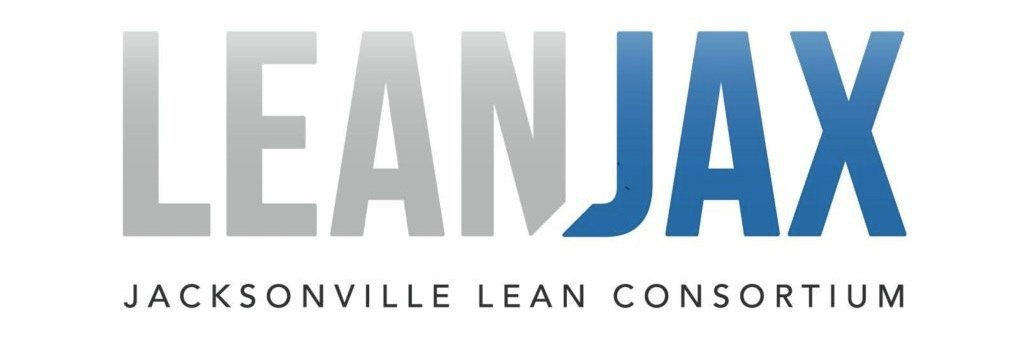8 First Coast Lean Practitioners Receive Certification from Lean Jax!
On June 10, 2021, 14 attendees participated in Lean Jax’s Introduction to Lean Manufacturing course, kicking off the organization’s 2021 Lean practitioner certification training series.
With several assignments, training sessions, and interviews remaining, the 2021 class is still in its’ early stages, but now is a good time to celebrate the accomplishments of the 2020 class.
Without further ado:
8 participants received their Lean Practitioner Certification from LeanJax on April 8, 2021:
Jamile Donovan and Matt Marone, BAE Systems
Adam Burkholder, Rulon International
Jerome Foster, Coastal Shower Doors
Lonnie Dyck, US Gypsum
Bill Holmes, Seal Shield
Matt Facemyer, Q-PAC
Thomas Rodrigues Commercial Metals Company
Certified Lean Practitioners
Are passionate for continuous improvement, possessing a healthy dissatisfaction for how work is currently done.
Demonstrate a clear understanding of Lean principles, culture, concepts, methods, and tools.
Tactically solve problems and implement Lean improvements within a work cell, work group, and/or value stream.
2020 Course Summary
The eight participants successfully met Lean Jax’s certification criteria, which included:
1. Attend and actively participate in the following training modules:
Introduction to Lean Manufacturing
The 8 Wastes and Bright Ideas
6S Workplace Organization
Visual Management and Mistake Proofing
A3 Problem Solving
Value Stream Mapping
Value Stream Mapping Project Report Out
2. Complete all assignments:
Conduct a structured Gemba Walk to identify the 8 wastes and select areas to target Lean improvements.
Apply 6S workplace organization to their area.
Leverage visual management techniques in their area (daily huddles, production analysis boards) to make incremental improvements.
Develop standard work in their key processes.
3. Attend one-on-one sessions with the instructors after each module.
These individual sessions provided the instructors with an opportunity to coach the participants and help them tailor the Lean operating system to their specific areas.
4. Pass a Lean practitioner certification examination with the scores over 80%
Shout out to Bill Holmes from Seal Shield for his perfect score!
5. Complete and report-out to class on value stream mapping project of a key value stream, using A3 problem-solving and DMAIC as a framework for making improvements.
For their final project, the participants completed a charter, current state value stream map, future state value stream map, and an A3 document that summarized learning and outlined next steps.
They leveraged the Lean principles and fundamentals covered throughout the class and made impactful improvements to their companies’ key cross-functional value streams.
Final Projects included:
Inventory control
Contract change orders
Setting up a new production line
Prevention of defective material from getting passed down stream
Moving from batch production to continuous flow
Cross-functional communication and contract and estimate pricing process
Mistake proofing a metal drill press
The participants strived to make measureable improvements to their organizations’ key result areas (quality, speed, cost, delivery, and safety) and achieved considerable success.
Results
Cut costs and improved customer delivery by reducing process lead time and inventory levels;
Freed up space on the shop floor and created safer work conditions by deploying 6S workplace organization, visual management, and standard work; and
Eliminated defects and opportunities for error through waste identification, mistake proofing, and A3 problem solving.
The practitioners are now tasked with completing their A3’s outstanding action items (training others on new standard work), auditing the results, then continuing their Lean Journey by spreading the principles and fundamentals to additional areas.
Feedback from the participants on their experience:
Thank you for a great class! Lean Thinking’s ‘Blame the process, not the people’ mindset resonates with me. I now quote this every time I see an opportunity for improvement. I learned that focusing on eliminating waste, work place organization, and visual standard work are the answer to the question: “We want to do it (Lean) but how do I get started?” Then you have to Sustain: Always seek ways to continuously improve, never accept the status quo as good enough.
I learned a lot from this course and I look forward to continuing my project under these lean principles. My biggest takeaway was the importance of going to the Gemba to show the employees that you care about them and their work, while also enabling them to contribute and grow.
I really had fun during this course you guys made it very interesting and interactive. The Lean culture’s motto: blame the process not the employee has definitely opened my eyes on how I may be able to fix some of these processes to make it easier and more efficient for myself and the employees.
Next Steps
Lean Jax would like to thank Mike Templeton from Templeton Manufacturing Solutions and FCMA for their promotion and support of our Lean practitioner certification series.
Additionally, we’d like to thank the impressive 2020 class of certified Lean practitioners for their engagement, consistent hard work, and unwavering commitment to continuous improvement— leaving the 2021 class with big shoes to fill. We’re excited to work with the new group, and if the initial session is any indication, they are more than up to the task!
For more information on upcoming training offerings and the benefits of becoming a LeanJax member, please reach out to:
James Bussell
Executive Director, Jacksonville Lean Consortium
Phone: 904-742-2547
Email: Leansupport@leanjax.org
“Thank you for a great class! Lean Thinking’s ’blame the process, not the people’ mindset resonates with me. I now quote this every time I see an opportunity for improvement. I learned that focusing on eliminating waste, work place organization, and visual standard work are the answer to the question: “We want to do it (Lean) but how do I get started?” Then you have to Sustain: Always seek ways to continuously improve, never accept the status quo as good enough.”
“Quisque iaculis facilisis lacinia. Mauris euismod pellentesque tellus sit amet mollis.”

